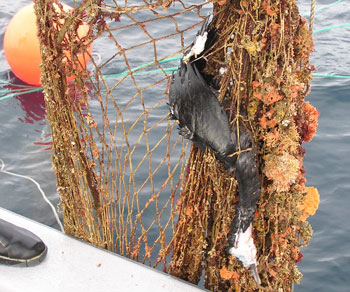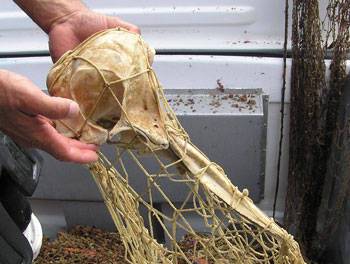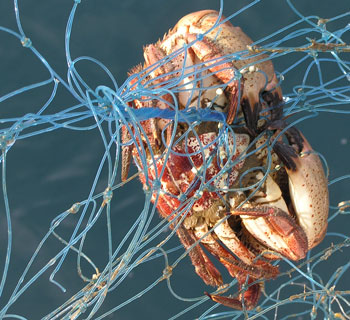Lost fishing gear is commercial and recreational fishing gear -- nets, traps, pots, line -- that becomes lost or is discarded in the water.
The gear ends up sitting on the sea floor, getting caught on rocky reefs, or floating in the water column.
The majority of this lost gear does not decompose in seawater and can remain in the marine environment for years.
Lost gear impacts the marine environment in several ways:
- it can continue to "catch" marine animals, which become entangled or trapped;
- it can damage the habitat upon which it becomes entangled or upon which it rests;
- it can pose an underwater hazard for boaters, entangling boat propellers and anchors;
- and it can similarly endanger humans, especially divers.
Lost gear is also a visual blight, diminishing the natural aesthetic quality of the seafloor and rocky reef habitat for underwater enthusiasts.
 SeaDoc works on derelict fishing gear in California and in the Salish Sea.
SeaDoc works on derelict fishing gear in California and in the Salish Sea.
California
Our executive director, Kirsten Gilardi, runs the California Lost Fishing Gear Recovery Project out of the Wildlife Health Center offices at the UC Davis School of Veterinary Medicine. (Dr. Gilardi is also co-director of the Mountain Gorilla One Health Project and the Envirovet Summer Institute.)
Click here for details on the California program.
 Salish Sea
Salish Sea
SeaDoc provides technical assistance and support for derelict gear removal in the Salish Sea. We have worked closely with the Northwest Straits Commission to analyze data from recovered nets to determine the economic impact of lost gear and its removal.
The results showed a clear return on investment for removing nets. For example, we calculated that an abandoned net might kill almost $20,000 worth of Dungeness crab over 10 years. Cost to remove? $1,358.00.
Click here to learn more about the economic impact of derelict gear.
Photos by Jen Renzullo. Video by Mike Neil.


